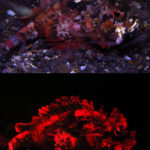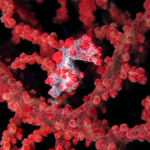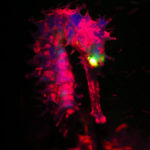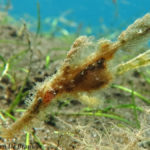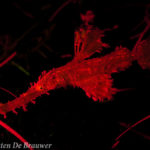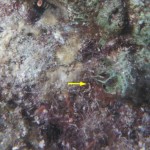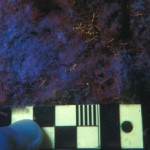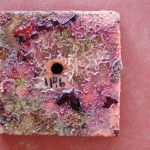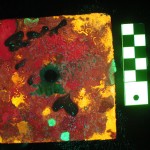Fluorescence Reveals Hard-To-Find Marine Life
You can’t study what you can’t see, and this can pose a real challenge if your research involves subjects that are small or well camouflaged. Fluorescence can help in some cases, significantly increasing the contrast against the background. This is nicely illustrated in two recent scientific papers. One (De Brauwer et al., 2017) assesses the value of fluorescence as a tool for surveying cryptic (highly camouflaged) fish species in the Indo-Pacific, while the other (Ford et al., 2017) uses fluorescence as a tool to help quantify juvenile coral density to help gauge the efficacy of coral reef management.
Maarten De Brauwer (a PhD candidate at Curtin University) is studying cryptic fish species and tested whether fluorescence might help in locating his subjects. He and his team dove with the Sola NIGHTSEA Fluorescence Excitation Light and yellow mask filter at several study sites, comparing fluorescence search to conventional white-light search. The results were both beautiful (see below pictures) and fascinating. Over the course of the study they observed specimens from 230 fish species and found fluorescence in 95 of them. For 73 of the species this fluorescence had not been described previously! Of the 230 species, 95 were cryptic and 83 of those (87%) were fluorescent. Only 12 of the 135 (9%) of non-cryptic species were fluorescent. The probability of species displaying fluorescence was much higher for cryptic than non-cryptic species – an intriguing and as yet unexplained observation. Using their new “Underwater Biofluorescence Census” (UBC) technique they found almost twice the number of pygmy seahorses (Hippocampus bargibanti) than were found using a standard “Underwater Visual Census” (UVC). When looking for two species of triplefin (Ucla xenogrammus, Enneapterygius tutuilae) they detected triple the abundance using UBC versus UVC.
- Bandtail Scorpionfish – white and blue light
- Hippocampus bargibanti – white light
- Hippocampus bargibanti – blue light
- Hippocampus histrix – blue light
- Hippocampus histrix – blue light
- Solenostomus cyanopterus – white light
- Solenostomus cyanopterus – blue light
The Ford et al. paper describes an assessment of ecosystem responses to community-based management in Fiji. Traditional methods for evaluating coral reef management effectiveness were not capturing the entire picture. The researchers compared “conventional metrics” to “resilience metrics” to judge the efficacy of coral reef management practices. “Conventional metrics” include categories like proportional cover of broad benthic groups and biomass of herbivorous fishes, while “resilience metrics” include categories like algal turf height, coral recruitment traits, juvenile coral densities, and herbivorous fish grazing rates. One challenge for the latter approach is that coral recruits and juveniles are very small and don’t look that much different than their surroundings, making them very difficult to find and count. The use of fluorescence for finding coral recruits and juveniles is a well established technique. The Ford et al. team used a GoBe NIGHTSEA high intensity blue LED lamp to quantify juvenile coral density as a resilience metric. They found that when using only conventional metrics to evaluate coral reef management they could document no management effect on benthic or herbivorous fish assemblages. However, the resilience based metrics indicated positive effects of management – especially within the benthic community. From this study the researchers were able to show that conventional metrics may not capture the entire picture when it comes to local management of inshore reefs, and that incorporating resilience-based metrics can strengthen their ability to predict the future conditions of reefs and their responses to disruption.
- Arrow pointing to juvenile coral, white light (c) Charles Mazel
- Juvenile coral <1mm diameter fluorescing (c) Charles Mazel
- Settlement tile – white light (c) Charles Mazel
- Settlement tile – fluorescence. Scale in cm. (c) Charles Mazel
Fluorescence is widely used in many fields of science and industry to highlight features of interest. The De Brauwer and Ford articles nicely demonstrate the potential for natural fluorescence to assist marine scientists in their research with hard-to-find organisms.
De Brauwer, M., Hobbs, J. P. A., Ambo‐Rappe, R., Jompa, J., Harvey, E. S., & McIlwain, J. L. (2017). Biofluorescence as a survey tool for cryptic marine species. Conservation Biology. doi: 10.1111/cobi.13033
Ford, A. K., Eich, A., McAndrews, R. S., Mangubhai, S., Nugues, M. M., Bejarano, S., … & Ferse, S. C. (2018). Evaluation of coral reef management effectiveness using conventional versus resilience-based metrics. Ecological Indicators, 85, 308-317. doi: 10.1016/j.ecolind.2017.10.002
Useful Links:
- De Brauwer et al. paper
- Maarten De Brauwer web site
- Ford et al. paper
- Sola NIGHTSEA
- GoBe NIGHTSEA
- Article – Fluorescence for coral recruitment research

